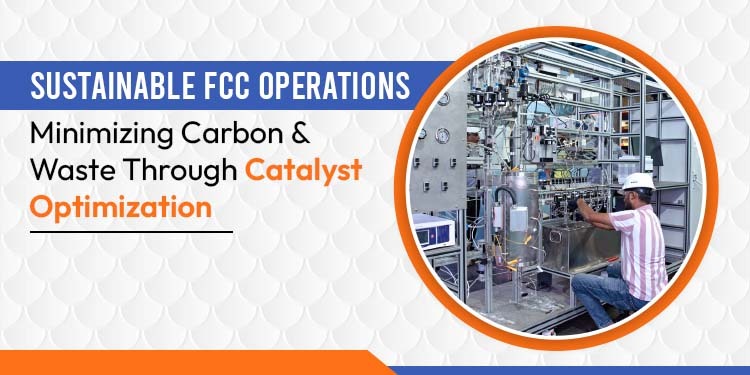Premier Pilot Plant People

Sustainable FCC Operations: Minimizing Carbon & Waste Through Catalyst Optimization
Fluid Catalytic Cracking (FCC) remains a cornerstone of modern refining, converting heavy hydrocarbon fractions into lighter, high-value products such as gasoline, olefins, and diesel. However, the FCC process is energy-intensive and one of the largest contributors to refinery CO₂ emissions. As global sustainability standards tighten and refineries transition toward low-carbon operations, optimizing FCC catalyst performance has become a crucial path toward reducing both carbon footprint and waste. Sustainability in FCC operations doesn’t only mean emission reduction; it involves maximizing energy efficiency, prolonging catalyst life, improving feed conversion, and minimizing waste generation, all while maintaining profitability and operational reliability.Understanding the FCC Catalyst and Its Impact
At the heart of the FCC unit lies the catalyst, a fine powder that facilitates the cracking reactions in a fluidized bed reactor. The quality and behavior of this catalyst directly influence yield distribution, conversion rates, and emissions. Over time, catalysts lose activity due to coke formation, metal contamination (Ni, V, Fe), and sintering, leading to increased fuel consumption and reduced efficiency. A sustainable FCC operation depends on managing these challenges through advanced catalyst formulations, efficient regeneration, and process optimization.1. Advanced Catalyst Formulation and Selection
Modern FCC catalysts are designed not just for performance but also for environmental responsibility. Innovations such as zeolite Y modifications, rare-earth stabilization, and matrix optimization help improve hydrothermal stability and resistance to metal poisoning.- Low Coke and Low Dry Gas Formulations: Catalysts with optimized pore structures promote better diffusion, reducing coke yield and dry gas production.
- Metal Passivation Additives: Compounds such as antimony and magnesium oxides help neutralize vanadium and nickel, extending catalyst life.
- Hydrogen Transfer Control: By fine-tuning hydrogen transfer properties, refiners can enhance gasoline selectivity while limiting undesirable aromatics.
2. Efficient Catalyst Regeneration Techniques
Regeneration is where most FCC-related CO₂ emissions originate. Spent catalysts coated with coke are burned in the regenerator, producing CO₂ and CO. Optimizing this step is crucial for sustainability. Modern techniques include:- Oxygen-Enriched Combustion: Enhances combustion efficiency, allowing lower air flow rates and better heat recovery.
- Two-Stage Regeneration: Separates partial and complete combustion zones to control temperature and limit overburn.
- Heat Integration: Using recovered heat to preheat feed or air reduces overall energy consumption.
3. CO₂ Capture and Emission Control Integration
FCC units are increasingly integrating carbon capture systems to curb emissions from the regenerator. Several technologies show promise:- Post-Combustion Capture (PCC): Uses amine-based solvents or solid sorbents to capture CO₂ from flue gases.
- Oxyfuel Combustion: Burns coke using oxygen instead of air, generating a concentrated CO₂ stream for easier capture.
- Chemical Looping Combustion (CLC): Employs metal oxides to transfer oxygen for combustion, inherently producing a CO₂-rich stream.
4. Catalyst Recycling and Circular Use
Sustainability extends beyond operation to end-of-life management. Spent FCC catalysts, traditionally treated as industrial waste, can now be repurposed:- Material Recovery: Extracting rare-earth elements (La, Ce) and metals (Ni, V) for reuse.
- Alternative Applications: Utilizing spent catalyst as an adsorbent in wastewater treatment, road base materials, or cement additives.
5. Role of Automation and Advanced Process Control
Modern FCC units increasingly rely on digital automation, predictive analytics, and SCADA-based control systems to optimize catalyst operations in real time.- Process Optimization: Continuous monitoring of riser temperature, regenerator air flow, and catalyst circulation rate ensures consistent performance.
- Predictive Maintenance: Machine learning–driven models (trained on process data) help predict coke buildup or regenerator imbalance before downtime occurs.
- Energy Optimization: Dynamic control systems minimize energy losses and maintain stable catalyst-to-oil ratios.
6. Benefits of Sustainable Catalyst Optimization
Implementing sustainable FCC catalyst practices leads to measurable improvements across operational, economic, and environmental dimensions:| Aspect | Sustainability Impact |
| Carbon Reduction | Lower regeneration emissions and improved energy balance |
| Resource Efficiency | Extended catalyst life, reduced replacement frequency |
| Operational Reliability | Stable yields and reduced equipment wear |
| Cost Savings | Lower energy and material consumption |
| Regulatory Compliance | Alignment with emission standards and sustainability targets |
Conclusion
The transition to sustainable FCC operations is not a distant goal; it’s an ongoing necessity. Through catalyst innovation, advanced regeneration, CO₂ capture, recycling, and smart process automation, refineries can minimize carbon emissions and waste generation while maintaining high yields and profitability. For companies like Xytel India, which specialize in pilot plant development and process automation, these sustainable strategies can be tested and validated at pilot scale before full implementation. Pilot plants play a vital role in simulating real refinery conditions, enabling refiners to optimize catalyst performance, evaluate emission control strategies, and achieve greener, more efficient operations.Get in Touch
You will be amazed as how partnering with us becomes a game changer in your quest for R&D glory.

 Call Us
Call Us